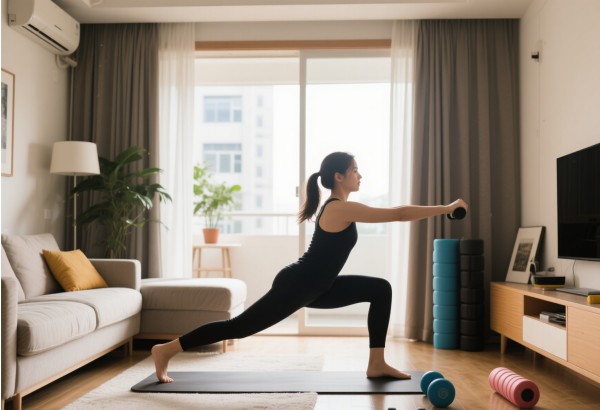Home Fitness Plan for Busy Professionals
推荐热门单曲:Drake的《God's Plan》 #生活乐趣# #生活分享# #音乐推荐#
The Real Challenges of Workplace Fitness
The fast pace of workplace life leaves many feeling time-starved. Early mornings and late nights, unexpected meetings, and a pile of emails often push fitness plans to the corner. The intertwining of physical fatigue and mental stress, along with shoulder and neck pain from prolonged sitting, back stiffness, and even a decline in physical fitness, all remind busy individuals that health needs to be actively pursued. Home workouts have become an ideal solution to this dilemma, saving commuting time to the gym while allowing for flexible scheduling. However, a lack of motivation, scattered plans, and difficulty in maintaining consistency often turn good intentions into illusions.
A marketing manager once tried morning runs but gave up due to overtime cutting into sleep; another programmer bought dumbbells but left them unused due to a lack of guidance. The success of home workouts lies not only in executing movements but also in aligning with the lifestyle rhythm of office workers. A sustainable plan should start with time management and psychological motivation, gradually integrating into daily life to form a habit. Understanding the fragmented time and energy fluctuations of office workers, such as the potential of evening relaxation periods, lays the foundation for designing a plan. This understanding serves as a starting point, igniting the spark for home fitness.
Assessing Time and Space Resources
The first step in creating a home fitness plan is to examine the available time and space resources. Office workers often have only scattered 30 to 60 minutes, and home space may be limited to a corner of the living room. Scientific planning must start from reality, tapping into the potential of fragmented time while using simple equipment to optimize the environment, ensuring that workouts are efficient and safe.
An accountant found that half an hour after lunch was the best time for mental clarity, switching to short training sessions that doubled the effectiveness; another designer laid out a yoga mat in the bedroom, saving time on setup. Time and space are like a canvas, outlining the contours of fitness.
Review the weekly schedule to identify 3 to 4 available 30-minute slots, such as early morning, after dinner, or weekend mornings. Record energy levels and prioritize moments when the mind is clear and distractions are minimal. Measure the space at home, ensuring at least 2 square meters of flat area, removing sharp objects to ensure safety. Prepare basic equipment, such as a yoga mat, a pair of 5 to 10 kg dumbbells, and resistance bands, with a budget of about 300 yuan, which is cost-effective. If space is limited, bodyweight training can also meet the needs. Try to be active for 5 minutes during the selected time slots, checking focus and comfort, adjusting to ensure there is no pressure. Record time allocation, such as feeling best at 7 PM, and optimize the schedule. A clear resource assessment paves the way for the fitness plan.

Designing an Efficient Workout Plan
An efficient home fitness plan needs to balance strength, endurance, and flexibility, addressing the pain points of prolonged sitting for office workers, strengthening the core, improving posture, and enhancing cardiovascular function. Training three times a week for 30 minutes each session is sufficient to bring about significant changes, with simple and easy-to-learn movements suitable for beginners and busy individuals.
A sales manager tried complex fitness videos but felt discouraged when unable to keep up; after switching to basic combinations, confidence soared. Another editor squeezed in three training sessions a week, alleviating shoulder pain and feeling revitalized. The workout plan is like a musical score, playing the vitality of the body.
Schedule three training sessions each week, with rest days in between to avoid fatigue. Each session should include 5 minutes of warm-up, 20 minutes of main training, and 5 minutes of stretching. Warm-up exercises can include jumping jacks and high knees to activate the cardiovascular system. The main training is divided into three days: Day 1 for strength, with 3 sets of 10 squats, 3 sets of 8 push-ups, and 3 sets of 10 dumbbell lateral raises to strengthen the legs, chest, shoulders, and core; Day 2 for endurance, with 3 sets of 30 seconds of burpees, 3 sets of 30 seconds of mountain climbers, and 3 sets of 15 bodyweight squats to elevate the heart rate; Day 3 for flexibility, with 5 cat stretches, 5 standing forward bends, and 5 side twists to relax the muscles. Rest for 45 seconds between sets, performing movements slowly to ensure proper form. Try a set of squats, checking that the knees do not extend beyond the toes, adjusting to avoid discomfort. Record training feelings, such as finding 8 push-ups to be moderate, and optimize intensity. A scientific plan makes workouts efficient and time-saving.
Optimizing Diet and Rest Support
The effectiveness of fitness is inseparable from the coordination of diet and rest. Office workers often disrupt their body rhythms due to takeout and late nights, affecting training results. A reasonable diet provides energy for muscles, and sufficient sleep promotes recovery. Simple adjustments can be integrated into a busy life, enhancing the sustainability of fitness.
A lawyer neglected protein intake, leading to slow strength gains; after adding chicken breast to meals, physical fitness improved. Another planner felt fatigued after training due to late nights; after going to bed early, energy levels surged. Diet and rest are like the foundation, supporting the longevity of fitness.
Consume a balanced diet daily, with protein making up 20%, such as chicken breast, eggs, or tofu, about 100 grams per meal; carbohydrates should be 40%, such as oats or whole wheat bread, providing energy; the remainder should be vegetables and healthy fats, such as olive oil or nuts. Eat a banana and a glass of milk 30 minutes after training to replenish glycogen and protein. Ensure 7 hours of sleep each night, turning off electronic devices an hour before bed to relax the body and mind. If there is a 20-minute break during lunch, close your eyes to rest and relieve fatigue. Try recording your diet for a day to check if protein intake is sufficient, such as 2 eggs being ideal, and adjust portions accordingly. Record sleep quality, such as feeling best after 7 hours, and optimize your schedule. Scientific nutrition and rest inject sustainability into fitness.
Cultivating Long-term Exercise Habits
A sustainable fitness plan needs to be integrated into life, becoming a natural rhythm of breathing. Office workers often overlook long-term persistence due to short-term enthusiasm; psychological motivation and environmental optimization can ignite inner drive, making exercise an indispensable habit rather than a burden.
A teacher gave up due to setting overly high goals; after switching to three times a week, they persisted for six months. Another consultant grew bored due to monotony; after adding music, they found joy in it. Habits are like rivers, nourishing the life of fitness.
Set small goals, such as completing 12 training sessions in the first month, recording each completion to enhance the sense of achievement. Pair workouts with upbeat music or listen to podcasts during training to increase enjoyment. Invite family or friends to supervise, such as sharing progress weekly and encouraging each other. Adjust movements monthly, such as swapping push-ups for planks to maintain freshness. Try recording your mood for a week to check if you feel happy after training, adjusting goals to be easily achievable. If you miss a day, there’s no need to feel guilty; just continue the next day. Record the number of consecutive days you stick to it, such as aiming for 7 days, and optimize motivation methods. Flexible strategies allow exercise to blend into daily workplace life.
Flexible Adjustments to Handle Unexpected Disruptions
The unpredictability of workplace life often disrupts fitness plans. Overtime, business trips, or family matters can derail schedules. Designing flexible coping strategies to ensure plans continue through setbacks is key to sustainable fitness. Busy individuals need to learn to find balance amid changes, turning challenges into opportunities.
A project manager stopped training due to a business trip, leading to a decline in fitness; after switching to bodyweight training, they could start anytime. Another customer service representative was interrupted by family matters; after shortening the duration, they regained their rhythm. Flexibility is like a sail, guiding the journey of fitness.
Prepare backup plans, such as doing 10 minutes of bodyweight training while on a business trip, including 10 squats, 10 push-ups, and 10 sit-ups, which can be completed in a hotel room. If feeling fatigued after overtime, switch to 15 minutes of yoga for stretching and relaxation to maintain continuity. When there are many distractions at home, choose quiet times in the early morning or late at night to focus on training. Record unexpected events for a week, such as two instances of overtime, adjusting to short training sessions and checking effectiveness. Try a backup plan, such as ensuring 10 minutes of bodyweight exercises flow smoothly, optimizing the combination of movements. Flexible adjustments keep fitness plans closely aligned with daily life.
Home fitness for busy office workers is a dual practice of body and mind. A scientific workout plan ignites vitality, while the coordination of diet and rest solidifies the foundation, and flexible habit formation sustains motivation. From squats on a yoga mat to the persistence of sweating each week, every drop of effort tells the pursuit of health. With careful planning, even a corner of home can become a source of energy, infusing every workout with new brilliance for workplace life.
网址:Home Fitness Plan for Busy Professionals https://www.yuejiaxmz.com/news/view/1137282
相关内容
my weekend plan我的周末计划作文(精选20篇)Plan your finances for parenthood
白领英语晨读经典365 163 Tips for Fitness 健身小贴士
关于健身的英语作文(精选24篇)
我的周末计划英语作文范文带翻译(通用20篇)
Fun entertaining home For Ultimate Enjoyment
BBC新闻:自主健身小贴士 !
BBC新闻:自主健身小贴士
精选健身英语作文范文(通用20篇)
自主健身小贴士

